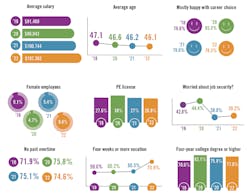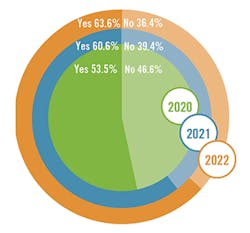Just as COVID-19 gets under control and begins to wane, it’s compounded by a cascade of overlapping dominoes. To varying degrees in different places and industries, shutdowns during the pandemic triggered shortages, wildly stretched supply chains, and unprecedented lead times for many technologies, such as two years or more for microprocessors, electronics and other products that rely on them. Because these disruptions show no signs of abating—and are exacerbated by Russia’s invasion and war in Ukraine—prices for many scarce items and resources have skyrocketed, while many less-affected suppliers have jumped on the bandwagon to recoup and/or gouge where they can.
Hip deep with everyone else in these collapsing card houses, process control engineers, operators, managers and support professionals have labored mightily to maintain production, and keep their organizations and customers up and running. They’re seeking new material sources, adapting designs and schedules, and otherwise innovating to give themselves, their clients and communities the flexibility and resilience they need to cope with recent difficulties. Of course, these latest problems further compounded by older ones, such as the longstanding brain drain in the process industries due to accelerating retirements, and the shift to digitalization that’s forcing almost everyone to reorganize and/or get reeducated.
The close to 200 respondents to Control’s 2022 salary survey are dealing with all these issues, which peer through in their collective answers, even as they maintain the steadfastness and consistency for which they’re well-known—and finally being justly rewarded. For example, challenging work remained their most important motivator, but compensation garnered a greater presence in 2022 than it had in previous years. In fact, salary and benefits related to job satisfaction shot up almost 10 percentage points to 30% this year from 20.9% last year, while challenging work dropped almost eight percentage points to 36.2% this year from 44.1% last year (Figure 1).
| 2018 | 2020 | 2021 | 2022 | |
| Challenging work | 37.7% | 45.3% | 44.1% | 36.2% |
| Salary/benefits | 23.4% | 17.8% | 20.9% | 30.0% |
| Opportunity for advancement | 10.5% | 11.6% | 10.0% | 12.3% |
| Job security | 12.2% | 12% | 10.9% | 10.0% |
| Appreciation | 14.4% | 12.4% | 12.3% | 7.7% |
| Other | 1.9% | 0.9% | 1.8% | 3.8% |
Figure 1: Challenging work is still the most popular contributor to job satisfaction for respondents to Control's 2022 salary survey, but that popularity cratered compared to last year. However, salary and benefits as they contribute to job satisfaction shot up close to 10 percentage points during the same period, perhaps fueled by concerns about inflation and scarcity. The need for appreciation also decline significantly.
Salaries up, fewer hours
Along with added focus on pay, average salaries for respondents to Control’s 2022 salary survey continue to push above $100K, increasing by close to 6.6% to $107,362 in 2022 from $100,744 in 2021. Also, respondents with four weeks or more vacation jumped more than 10 percentage points to almost 71% this year from just over 60% last year.
These gains continue to be more remarkable because the average ages and experience levels of the respondents in 2022 were largely the same as the year before. Plus, the percentage of women among the respondents jumped four percentage points to 9.4% this year from 5.4% in 2021. This just the second time more than 9% of the survey’s respondents were female (Figure 2).
Figure 2: Continuing its march above $100,000, the average salary for respondents to Control's 2022 salary survey posted an almost 6.6% increase from the year before, topping $107,000 for the first time. These gains continue to be extraordinary because respondents' average age and percentage with PE licenses continued to decrease slightly. Likewise, the ratio of female engineers and technical professionals gained four percentage points, rising above 9% for just the second time. However, even though the COVID-19 pandemic was joined by supply chain snarls and inflation, concerns about job security increased by less than half a percentage point, while respondents' happiness with their career choices decreased by slightly more than one percentage point.
Likewise, those with more than 30 years of experience in process control decreased again. They declined more than five percentage points to 22.5% in 2022 from 27.9% in 2021, which was a more than four percentage point drop from 32.2% in 2020. Meanwhile, respondents with 11-20 years of experience increased by six percentage points to 26.1% this year from 20.1% last year.
Another factor that seems to fly in the face of recent pay hikes—shorter work weeks. For example, 55.5% of respondents worked 41-50 hours per week in 2022, which was a more than 11 percentage point drop from the 67% who worked 41-50 hours per week in 2021. Meanwhile, 28.4% worked 31-40 hours per week this year, which was an almost 12 percentage point increase from the 16.5% working 31-40 hour per week last year.
Just as total work hours generally increased when more personnel worked at home during COVID-19, it’s possible that total work hours are decreasing as more employees are returning to work onsite and have to spend more time physically commuting. This trend is likely supported by the fact that telecommuting by the respondents dropped more than eight percentage points to 25.2% in 2022 from 33.3% the year before.
| 2018 | 2020 | 2021 | 2022 | |
| Received raise up to $4,000 | 81.6% | 74.2% | 78.7% | 76.8% |
| Received bonus | 64.1% | 61.4% | 62.6% | 66.9% |
Figure 3: Bonuses took the lead in 2022, increasing more than four percentage points to 66.9%, while raises decreased almost two percentage points to 76.8%, possibly due to a combination of retirements by higher-paid staff, inflationary pressures and companies refocusing on external recruiting.
Desperately seeking staffers
Though it hasn’t gained as much recent attention as supply chain snags and inflation, the other major undercurrent in the wake of COVID-19 is turbocharged retirements among engineers, technical professional and veteran employees in practically every field. This is likely keeping salaries elevated and workweeks shorter, but it may also be fueling bonuses, too. Among the respondents to Control’s 2022 salary survey, bonuses increased more than four percentage points to 66.9% this year from 62.6% last year, Meanwhile, raises up to $4,000 ticked down less than two percentage points to 76.8% in 2022 from 78.7% in 2021 (Figure 3).
Not surprisingly, persistent and mounting staffing shortages are making recruitment, hiring and retention efforts far more urgent. This year’s respondents added that hiring jumped more than five percentage points to 45.7% in 2022 from 40.4% last year. This was backed up by a close to nine-percentage-point drop in layoffs to 13.4% this year from 22.2% last year, while promotions and raises increased almost four percentage points to 14.3% in 2022 from 10.3% last year (Figure 4).
Figure 4: A more than five-percentage-point increase in hiring reported in Control's 2022 salary survey was backed up by a close to nine-point drop in layoffs, and an almost four-percentage-point increase in promotions and raises. These shifts have been driven for years by increasing retirements, but are likely accelerating recently due to supply chain issues, inflation and other fallout from COVID-19.
Because its process division works mostly in the food and beverage, life sciences and consumer packaged goods industries (CPG), Gray Solutions was busier than ever during the pandemic, and grew from 40 employees in March 2020 to about 270 at present. The four-year-old system integration division is a certified member of the Control System Integrators Association (CSIA) and part of Gray Inc., a family- and employee-owned solutions provider.
“We say we’re not just smart, but also lucky because we built our system integration business in 2018, and it just snowballed after COVID-19 hit,” says Walker Mattox, CEO at Gray Solutions. “System integration is a different model, accounting structure and way of thinking than pure construction because it’s more people-focused and customer-oriented. We added project managers and control and digital transformation engineers as our projects increased, and added 70 people after acquiring Stone Technologies in February 2021. We also benefitted by adopting its work-from-anywhere platform, though staff can still come to one of our U.S. hubs in Lexington; St. Louis; Anaheim, Calif.; and Charlotte, N.C., when they need to do especially important jobs like meeting with customers to complete designs or factory acceptance tests (FAT). Recent hires say a physical site shows commitment to investing in people.”
Mattox reports it was difficult to do all the recruiting needed for Gray Solutions to grow from 40 to 270 employees. “It was hard work every day, and took a lot of personal time and energy, but we turned the recent great resignation into a great attraction. I wish there was a secret, but it was just a lot of work,” adds Mattox. “LinkedIn is our biggest recruitment vehicle, but it was also crucial to have a strong network with three or four external recruiting companies, and a strong internal referral program. This is done by treating new hires well, with competitive salaries and benefits, bonuses twice per year, and an annual party for them and their families. This helps with retention, but it also maintains our pipeline to other potential new hires.”
Mattox explains that Gray’s efforts aren’t just about compensation, but are mainly concerned with making people feel valued. Each staffer has a quarterly four-by-four conversation with their manager, in which they try to cover four primary questions: what was their most significant accomplishment this quarter? What will they work on next quarter? What obstacles are they encountering? And what can their manager or Gray Solutions do better to support them?
“It’s also important to not underestimate how much time recruiting and retention requires, and to spend more time on them,” adds Mattox. “It’s important to respect who we work with, so we also look for customers, who are in line with our values, which are putting safety and quality of life first, being customer- and relationship-driven, and treating others the way we want to be treated. For example, if a staffer is on a vacation week, we don’t bother them, and we let our customers know they need to understand this, too. It’s easier said than done, but making these efforts is important. The first task is locking out time for leaders to focus on people, recruiting and retention. It’s a good idea for them to start with about 50% of a typical 40-hour work week, or about 20 hours on listening to managers and personnel. This isn’t new, but it can be groundbreaking.”
| 2020 | 2021 | 2022 | |
| Medical insurance | 91.1% | 88.6% | 84.4% |
| Life insurance | 69.6% | 76.3% | 75.6% |
| Dental insurance | 70.5% | 70.3% | 65.2% |
| 401K | 58.9% | 65.3% | 57.8% |
| Disability | 56.7% | 60.3% | 57.8% |
| Flex Time | 38.8% | 35.2% | 34.8% |
| Family Leave | 32.6% | 32% | 28.9% |
| Tuition reimbursement | 35.7% | 35.2% | 27.4% |
| Pension | 28.6% | 26.5% | 25.9% |
| Telecommuting | 30.4% | 33.3% | 25.2% |
Figure 5: Non-compensation benefits in the process industries remain mostly consistent over the years, but respondents in 2022 reported single-digit percentage-point decreases in almost every category compared to the year before. Even telecommuting declined by more than eight percentage points, likely due to many employees heading back to onsite work in the wake of the pandemic.
Benefits and recruiting strategies
To retain existing personnel and attract new ones, most employers in the process industries and everywhere else offer a selection of basic benefits along with their salaries, such as medical and dental health insurance, life insurance, 401K retirement plans, short- and long-term disability, flex time, family leave, tuition, pensions and other items. The respondents to Control’s 2022 salary survey are also receiving many of these benefits, which typically remain consistent over the years because they’re part of the compensation packages that almost every professional expects from any employer.
However, while a majority of respondents get medical, life, dental, 401K and disability, only about a quarter to a third get the others. In addition, even as they gained in pay and other areas, these basic benefits have steadily eroded in recent years. In fact, in every category in 2022, a smaller percentage respondents received these benefits (Figure 5). There didn’t appear to be any obvious explanation, but it could be that increasing retirements by veteran staffers resulted in fewer traditional benefits carrying over to the rookies replacing them. Plus, if average pay continues to increase, more employees may also demand more non-compensation benefits, too.
To identify and attract new staffers, this year’s respondents report their companies use a series of time-tested strategies. These include several in-person methods they’re redeploying as COVID-19 started to wane, organizations reopened, and more travel and face-to-face meetings became possible. As usual, social media tools like LinkedIn and Facebook continued to be used by more than half of respondents, while print or online advertising continued to decline. However, open-house events, internships and co-op programs, visits to nearby schools and colleges, and sponsoring local science, technology engineering and math (STEM) teams all increased approximately four percentage points this year after previous, pandemic-based declines. There were even a few more respondents developing process control and automation educational content and teaching at their local schools and colleges (Figure 6).
Figure 6: Following pandemic-related downturns in 2021, recruiting activity gained in several areas this year, according to respondents to Control's 2022 salary survey. These categories included social media platforms and in-person formats, such as internships and co-op programs, visits to local schools and colleges, sponsoring STEM programs, hosting open-house events, and teaching process control and automation classes at local colleges and high schools.
“We tap staff expertise, human resources and marketing to help with recruiting, but it’s also essential to get as close as possible to schools and educators. That’s why we get involved with students’ capstone projects, sponsor guest lecturers, and provide advice on curriculum at Lake Superior State, Oakland University and several community colleges,” says Diane Haig, chief knowledge officer (CKO) at Applied Manufacturing Technologies (AMT) in Orion Township., Mich., a system integrator and CSIA member located just north of Detroit. “Our clients tell us their headcount is limited, too, and they’re asking us to get involved with students before they graduate.”
Haig reports that AMT has succeeded in its recent recruiting efforts by adopting a generous bonus-for-referrals program, and working with a third-party marketer to boost its social media presence on LinkedIn, Facebook and Twitter. This social media content often features AMT employees and projects. These efforts dovetail with its educational outreach.
“When we go to schools, we bring along recent graduates we’ve hired, who can also talk to prospective candidates about projects and working at AMT,” explains Haig. “Our COO is a Lake Superior State graduate, who maintains ties with the university, has longtime relationships with its professors, and can talk to its students about us. We’ve also returned to in-person interviews lately, and we’re very enthusiastic about the positions and training we have available. Once we get prospects in the door, we usually succeed in hiring them.”
However, Haig cautions that providing the services of a system integrator requires a lot of training and travel, which can make it difficult to retain some employees. To give its staffers the instruction they need and boost its chances of retention, AMT offers personnel online courses from Coursera and Udemy, as well as product-specific instruction from Rockwell Automation and other suppliers. “Staffers have to want to learn and put the time in,” adds Haig. “We all do continuous development. Our president values and encourages continuous learning. And our senior engineers always try to keep learning and then mentor others. It’s a very a cultural thing.”
Haig reports that AMT has even organized and offered its own Automation Academy for many years. It consists of classes by engineering leaders and plant-floor experts, and has an evolving curriculum. Previously, it covered many robotics topics, but now it offers more training on industrial controls and the soft skills employees require to handle themselves when working with clients.
“We’ve also learned the value of breaking some rules,” adds Haig. “For instance, it’s important to maintain consistency, but instruction isn’t written in stone. We’ve come to understand it’s crucial to recognize that people are different and absorb information in different ways. Consequently, we have to present instruction in the best ways for them to learn it. Online courses and videos are OK, but hands-on with a mentor on the plant-floor is better. Even though it’s an investment, we recommend starting an academy program. There’s no immediate ROI and it may just bring in attendees that are unbillable for a while. However, if they can be specific about what they need, they can develop a strong culture with members that support each other.”
| 2018 | 2020 | 2021 | 2022 | |
| No program | 60.2% | 57.7% | 59.0% | 56.8% |
| 1 year or less | 18.8% | 20.7% | 18.9% | 22.3% |
| 1-3 years | 11.3% | 10.6% | 14.0% | 11.5% |
| 3 years or more | 3.0% | 4.0% | 2.7% | 5.0% |
| Length varies | 6.7% | 7.0% | 5.4% | 4.3% |
Figure 7: Just as the recovery from COVID-19 has progressed unevenly in difference places, apprenticeships of some lengths increased slightly in 2022, while others decreased slightly.
Haig adds that an extra benefit of these efforts will be good habits that survive and make it easier to handle unexpected problems in the future. “When the pandemic started, our executive held daily standup calls and met twice per week on certain issues, while our president provided daily emails to our staff on status updates, projects and personal news,” says Haig. “We all communicated on a daily basis for six to eight months, and the staff really seemed to appreciate it.”
Backing up progress—or not
While there’s much to celebrate in the increasing salaries and other gains achieved by respondents to Control’s 2022 salary survey, there were also indications that long-term support for these improvements might be as solid as they appear. For instance, apprenticeship programs of a year or less and three years or more expanded by two to three percentage points this year, while one-to-three-year apprenticeships lost two and a half percentage points (Figure 7).
Figure 8: While they report being happier with their basic skills this year, respondents to Control's salary survey add that eight percentage points fewer of their companies support skills training. Almost 14 points more report that training isn't supported due to lack of management commitment, even though lack of time decreased as a reason for poor support. At the same time, self-study, employers and other training firms decreased slightly as training sources, but on-the-job training from colleagues shot up almost 12 points.
Figure 9: As expected, adoption of Industrial Internet of Things (IIoT) devices and related networking gained another three percentage points to reach 63.6% in 2022, after gaining more than seven percentage points the year before. These include process control and automation users and applications, which have been implementing Ethernet hardware and communication protocols, Internet protocol (IP) and web-based interfaces, and edge- and cloud-computing services and other IIoT-enabled capabilities.
Similarly, while respondents who are happy with their basic skills increased four percentage points in 2022, those who are unhappy with their skills increased close to three percentage points. The bad is that companies that don’t support skills training increased more than eight percentage points to 26.1% this year from 17.7% in 2021. The good news is that on-the-job training by colleagues almost doubled to 24.4% in 2022 from just 12.5% the year before, even though other training sources like self-study, employer and other training firms decreased a few points. Notably, while lack of time and money are usually the reasons that training isn’t supported, this year’s respondents reported that lack of management was the primary cause. In fact, lack of management shot up almost 14 percentage points to 35.4% this year from 21.5% last year (Figure 8).
IIoT and digitalization keep gaining
Finally, it’s becoming clear that, pandemic or no pandemic, implementation of the Industrial Internet of Things (IIoT) and overall digitalization is going to keep on taking over more of the control, automation, process and other industries no matter what else happens. This year’s respondents reported that IIoT-enabled components and supportive networking gained another three percentage points to reach 63.6% in 2022, after gaining more than seven percentage points the year before. These include process control and automation users and applications, which have been implementing Ethernet hardware and communication protocols, Internet protocol (IP) and web-based interfaces, and edge- and cloud-computing services and other IIoT-enabled capabilities (Figure 9).











